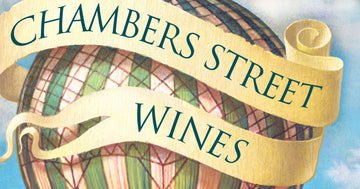Heroes of the Nahe part 1: Gut Hermannsberg
6/23/23 -


Sitting directly across the Nahe and the town of Oberhausen, home of the famous Donnhoff, we climb up the hill to find ourselves at Gut Hermannsberg and its spectacular towering and massive vineyards. Considered in Germany as Donnhoff's equal, Gut Hermannsberg was created at the turn of the 20th century, in part, from an ancient coppermine that was converted into the famous Kupfergrube vineyard. Although there have been vineyards on the Nahe since the late Roman period, the estate was founded in 1902 as the Royal Prussian Domaine (hence the spread eagle logo)! The first harvest was in 1907, but it was with the nobly sweet wines of the great 1921 vintage that the estate achieved its breakthrough. From 1949 the dynamic duo of estate director Hermann Goedecke and winemaker Karl-Heinz Sattelmeyer made the estate’s wines world famous. In 1998 the estate was privatized by the state of Rheinland-Pfalz and in 2009 the Reidel family purchased it (yes, that Riedel). In 2010 the former Nahe State Domaine was renamed Gut Hermannsberg. The cellar was modernized with the addition of the copper cube entrance to the winery below and the original estate buildings were renovated.

To put it in perspective historically, we turn to Helmut Donnhoff being interviewed by Stuart Piggott, Germany's top wine critic: "For a long time, the domain was dominant in the region. It floated like a UFO - different from every other wine producer in Germany. The detailed knowledge of the employees, their love of the vineyards and great winemaking talent made a deep impression upon me. You need to regularly invest in a winery with such a high profile and the Prussian State sure did." The Domaine consistes of seven vineyards as seen on the map below, which were ranked as Grosse Lage or Grand Cru by the VDP. Their philosophy is very strict: “Everything that a wine needs comes from the vineyard. That’s where the focus of our work lies. We don’t take anything away from our wines or add anything to them. In this way, very natural, original, honest and great wines come into being.” Everything is fermented with native yeasts and nothing is filtered or fined.


We are fortunate to have a nice lineup to offer in this email allowing us to look at the single vineyard GGs of Steinberg, Bastei and Rothenberg as seen in the map above (we are waiting for the Kupfergrube and Hermannsberg to arrive on the next boat and article). Starting with the Steinberg which lies adjacent to the Kupfergrube, it is surprisingly a completly different soil type to it's neighbor's copper rich red soil. Steinberg is all volcanic porphyry; because it's soil is so pale it remains cool, like the soil in the Grand Cru vineyards of Chablis, where the chalk-rich Kimmeridgean soil is also pale in color.

We then follow the Nahe east until suddenly, a massif outcropping of giant cliffs appear out of nowhere. These are the over 1000 feet high Rotenfels, German for red cliffs (they glow blazing red at sunset as I can attest) This gigantic mass of volcanic rhyolite is the highest inland cliff between the Alps and Scandinavia. Born from a volcanic eruption 270 to 260 million years ago, the Rotenfels was cut from centuries of weathering and erosion by the Nahe River.

The soil is composed of the fragments that fell off the cliff over thousands of years and collected as scree at its base. The Bastei vineyard consists of only a couple of rows at the cliff's' base just above the road, train track and Nahe river. As the train exits the tunnel and the cliffs appear directly in front and above, I was reminded of Ansel Adams's pictures of the red cliffs of Yosemite, we could've been on a train in the Wild West!


Next, we turn south at the tributary of the Alsenz river and follow it up to the Altenbamberger Rotenberg (Red Mountain). Standing at the top of the steepest and most windswept of their vineyards and looking out over the undulating landscape it feels like you’ve reached the end of Germany, or maybe have been beamed back in time several centuries in the semi-wilderness! Where exposed, the red volcanic rhyolite bedrock of this precipitous slope looks like the surface of Mars! It gives the dry Riesling GGs (first vintage 2015) a smoked bacon character that’s married to fine stone fruit and citrus aromas.
Of course, we would be remiss not to include some everyday drinking wine: Their 7 Terroirs and the Riesling Sekt Brut. Prost! Giselle Hamburg


